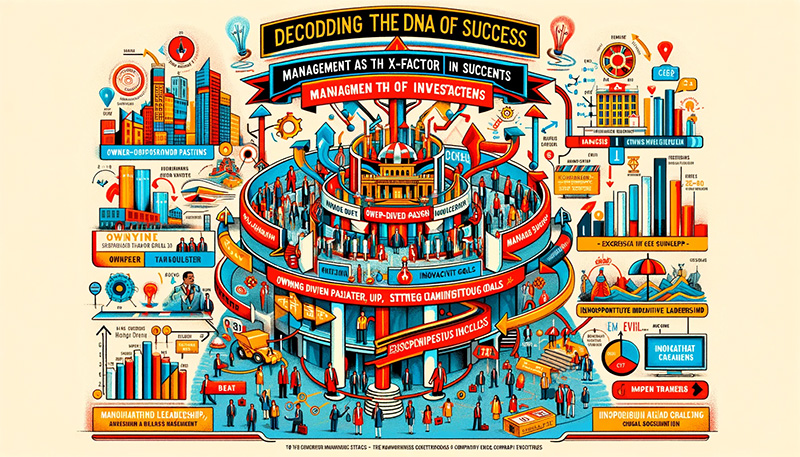
The investment landscape is a labyrinthine maze, brimming with hidden gems and treacherous pitfalls. But fear not, intrepid investors! For within the 6M framework lies a potent compass, guiding you towards the riches buried deep within the market. Meaning, Moat, Management, Margin of Safety, Market Knowledge, and the ever-elusive Moxie-ism – these are the six pillars upon which informed investment decisions are built.
Today, we turn our spotlight to the third M: Management. Beyond a company’s purpose (Meaning) and its competitive edge (Moat), it is the leadership team that stands as the architect of its future. Their vision, drive, and ethical fiber hold the power to transform potential into profit or watch empires crumble before their eyes.
This framework, forged in the crucible of experience and honed by market wisdom, empowers you to dissect the DNA of leadership, unveil the red flags that scream caution, and identify the companies with the moxie to dominate their industries. So, sharpen your analytical daggers and prepare to embark on a journey through the 6M’s, where Management takes center stage, revealing its power to unlock unparalleled investment success.
Remember, in this labyrinthine market, the 6M’s are your torch, illuminating the path to investment wisdom. Let’s begin with Management, the architect of destiny and the key to unearthing the true potential hidden within every business.
The Indian investment landscape is a vibrant tapestry woven with diverse threads of opportunity. Yet, amidst the dazzling array of numbers and charts, one element reigns supreme: management. A skilled, visionary leadership team can be the alchemist, transforming potential into profit and propelling a company toward the pinnacle of success. Conversely, a dysfunctional or self-serving management can unravel even the most promising venture, leaving investors with nothing but regret. This article dissects the intricate DNA of effective management, identifying the hallmarks of success and the red flags that scream caution, all through the lens of prominent Indian companies.
Owner-Driven Passion: The Bedrock of Commitment
In the Indian context, owner-oriented management often serves as the bedrock of a company’s success. When the owners are not just stakeholders but deeply invested individuals, their passion translates into unwavering commitment and a long-term perspective. This fosters strategic decision-making, a focus on sustainable growth, and a willingness to weather short-term turbulence for the sake of long-term value creation.
Consider the Tata Group, a behemoth spanning diverse industries. The family’s ownership imbues the group with a unique ethos of social responsibility and long-term vision. This commitment has not only driven consistent financial performance but also garnered immense trust and goodwill, making the Tata name synonymous with reliability and integrity.
Driven to Excel: The Engine of Innovation
Beyond ownership, a company needs a leadership team fuelled by an insatiable drive to excel. These individuals are not content with the status quo; they are relentless in their pursuit of improvement, innovation, and growth. They are agile and adaptable, embracing change as an opportunity to disrupt the market and redefine success.
Take, for example, Reliance Industries, led by the visionary Mukesh Ambani. His unwavering ambition has transformed Reliance from a textile giant into a diversified conglomerate with interests in energy, petrochemicals, telecom, and retail. Ambani’s relentless focus on innovation and disruption has not only propelled Reliance to become India’s most valuable company but also positioned it as a global leader in its chosen sectors.

Big Audacious Goals (BAGs): Aiming for the Stars
Exemplary management teams are not content with simply meeting expectations; they set audacious goals that stretch the boundaries of possibility and inspire the entire organization. These BAGs serve as a guiding light, shaping strategy, motivating employees, and attracting investors who believe in the company’s potential to achieve the extraordinary.
Consider the example of Marico, a leading FMCG player. Their BAG of “becoming a global leader in healthy food” may seem ambitious, but Marico’s consistent innovation, strategic acquisitions, and focus on organic growth have propelled them towards achieving this goal. Their commitment to their BAG has not only garnered investor confidence but also positioned them as a leader in the growing health and wellness market.
Red Flags: When to Hit the Brakes
While owner-oriented passion, a drive to excel, and a BAG are positive indicators, investors must also be wary of red flags that can signal potential mismanagement, misaligned priorities, or ethical concerns. These red flags can erode investor value and lead to disastrous consequences.
One such red flag is excessive insider trading, particularly when it exceeds 30% of the stock. This often indicates a lack of confidence in the company’s future or a desire for short-term gains at the expense of long-term shareholder value. Recent insider trading allegations against a prominent Indian pharmaceutical company serve as a cautionary tale, highlighting the potential for such actions to damage investor trust.
Another red flag is exorbitant CEO compensation, particularly when it is not linked to company performance. This can signal a disconnect between the management and the interests of shareholders, breeding resentment and eroding trust. The recent controversy surrounding the compensation packages of some Indian CEOs, despite lackluster company performance, underscores the importance of aligning executive compensation with shareholder value creation.
Beyond the Numbers: A Holistic Approach to Management Assessment
Evaluating management effectiveness requires looking beyond the glossy veneer of financial metrics. Investors must delve deeper, considering factors such as the team’s cultural fit, their ability to attract and retain talent, their commitment to environmental and social responsibility, and their track record of delivering on promises.
For instance, Godrej, a diversified conglomerate, has built a strong reputation for its commitment to sustainability and employee well-being. This has not only attracted top talent and fostered a positive work culture but also endeared them to environmentally conscious consumers, ultimately translating into long-term financial success.
Management – The Mastermind Behind Investment Success
In the dynamic and often unpredictable world of Indian investments, management serves as the mastermind, orchestrating the symphony of success. By understanding the nuances of owner-oriented passion, a drive to excel, audacious goals, and potential red flags, investors can decipher the DNA of effective leadership and identify companies with potential.
Next: Margin of Safety: The Keystone of Prudent Stock Market Investing.
Prof. Dr. Prahlada N. B
13 December 2023
Chitradurga.

















[…] Next: Management as the X-Factor in Indian Investment. […]
ReplyPrahlada Sir,
As rightly pointed by you…..
Investing in Indian companies, has to be done with wisdom & careful consideration.
You suggested some good Indian companies to invest in, like Reliance,Tata,Godrej….all of which have very good leadership, financials,competitive position, management quality, sustainable business models & solid long-term growth potential.
It is to be remembered here that investing always carries a level of risk, & it is essential to make decisions, based on our risk tolerance,investment goals & our own financial position.
Reply